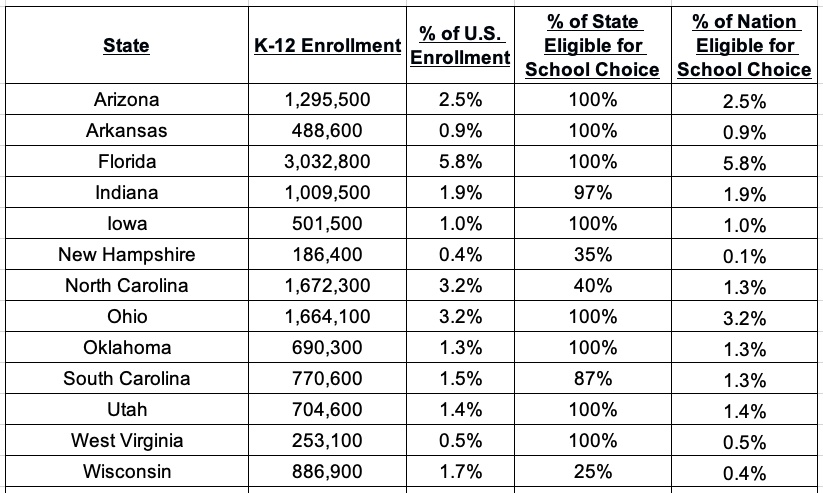Just in time for Independence Day, Ohio families can finally declare independence from the district school monopoly.
Over the weekend, Ohio lawmakers passed a state budget that expands eligibility for the state’s EdChoice Scholarships to all K-12 students. Gov. Mike DeWine signed the bill into law on Monday, making Ohio the eighth state in the nation to pass a universal school choice policy and the sixth state to do so this year, following Arkansas, Florida, Iowa, Oklahoma, and Utah.
Universal school choice is when education choice is offered to all students in a state, not just those who are low income or who have special needs.
Several other states also expanded their education choice policies already this year, including Alabama, Indiana, Montana, New Hampshire, and South Carolina.
Starting this fall, children from Ohio families earning up to 450% of the federal poverty line ($135,000 for a family of four) will be eligible for full scholarships worth about $8,400 (up from about $6,150 last year). Children from families earning above that threshold will be eligible for partial scholarships that will be adjusted based on income.
The dramatic expansion of education choice policies throughout the country has been an underreported story. Just two years ago, West Virginia became the first state to enact a publicly funded education choice policy for all K-12 students, allowing students to take some share of the money that would have been spent on their public school education and apply it toward private schools, homeschooling, or other alternatives.
Arizona followed suit last year when it expanded its K-12 education savings accounts policy to all students.
With the six additional universal policies this year plus expansions of more modest programs in several other states, more than 1 in 5 (more than 10 million) K-12 students are now eligible for education choice nationwide.
If North Carolina also expands its education choice policy to all students (currently, only 40% of North Carolina students are eligible), as it is expected to do, then nearly 1 in 4 students across America will be eligible for school choice. And if Texas finally enacts an education choice policy in a special session later this year, it would bump that national number up to 35% of students, or nearly 18 million of America’s 52 million K-12 students.

Moreover, these figures do not even include students eligible for privately funded tax-credit scholarships or publicly funded scholarships for students with special needs. Including them could yield an eligibility rate north of 40%.
Back in May, an article in The Hill asked whether the school choice movement is “about to hit a wall.” The article’s author seemingly consulted a diverse group of policy wonks and advocates ranging from school choice skeptics to school choice opponents, and the “consensus” was that “school choice advocates are quickly running out of states welcoming to their policies.” Apparently, no actual school choice advocates were available to ask their thoughts on the matter.
Meanwhile, policymakers in multiple states were busy moving legislation that would dramatically expand school choice while GOP primary voters in Virginia were busy voting for candidates who support school choice to replace ones who had not.
To paraphrase Aragorn from “The Lord of the Rings”: A day may come when the school choice movement hits the proverbial wall. But it is not this day.
Parents are still hungry for schools that align with their values and best meet the needs of their children—including those who live in the dwindling number of states lacking a school choice policy.
Policymakers in those states might soon find that the school choice successes outside their borders have served to whet parents’ appetites and created a demand that they ultimately no longer will be able to ignore.
This piece originally appeared in The Daily Signal





